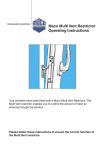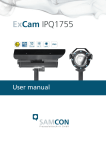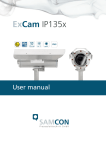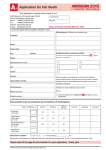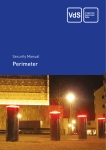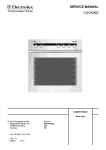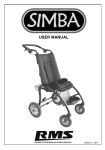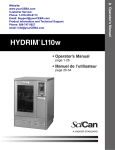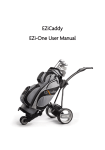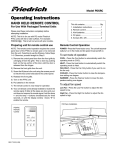Download PDF | EN | 969.33 KB
Transcript
TECHNOLOGY IN MOTION MACO MULTI TURN-ONLY AND TURN&TILT HARDWARE Operating and service manual for turn-only, turn&tilt and tilt-first hardware END USER MACO MULTI Contents Stipulated application and misuse 3-4 Safety and warning information 5-6 Operating instructions 7 Operating and cleaning information Maintenance information 8-9 10 - 13 Spare parts, customer service and disposal 14 T hese operating and maintenance instructions are intended for the user (end user) and must be kept for future reference. For safety reasons, all users must be informed of their content. If it is not certain that the information is available to all users, then a sticker must be attached to the window or a tag must be attached to the handle! This guide is also available at www.maco.eu for download, order number 757071. -2- MACO MULTI Stipulated application and misuse Proper use For windows or casement doors with MACO turn-only or turn&tilt hardware, window or casement door sashes can be opened inwards by shifting the hand lever to a certain turning position or tilted to a position limited by the scissor stay for the scissor stay version. When closing a sash and when locking the hardware in place, the resistance of the seal must be overcome as a rule. WARNING!Risk of injury and property damage by improper opening and closing of sashes! Improper opening and closing of the sashes can cause serious injury and considerable property damage! For this reason: ■ Ensure that the sash is guided through its entire range of motion to the fully closed position by hand and that it is brought very slowly and without resistance to the frame! ■ Ensure that the sash never slams in an uncontrolled manner or is allowed to swing open (wind or draught)! ■ Ensure that when closing the sash does not hit the frame or another sash (3-sashed window)! Any use beyond the range of stipulated application or other use or processing of the products is considered misuse and can lead to dangerous situations! WARNING!DANGER DUE TO MISUSE! Misuse of windows and casement doors can lead to dangerous situations. In particular, the following applications shall be avoided (see also safety instructions): ■ Deliberate or uncontrolled slamming or pushing of windows and casement doors against the window reveal. This can cause the hardware, frame materials or other components of windows or casement doors to be damaged or destroyed. ■ Introduction of obstacles into the opening vicinity between the frame and the window or casement door sash! ■ Intentional or negligent application of additional loads acting on windows and casement door sashes. -3- MACO MULTI ■ Closing of windows and casement doors with excessive force. The sash must always enter freely into the frame without effort. CAUTION!In the event of visible damage or improper function, the window or balcony door sash may no longer be operated and must be repaired by a certified specialist! i Important!Claims of any kind arising from damage caused from improper use or misuse are excluded from the warranty! Note relating to restriction of use: Opened window sashes and casement doors as well as windows and casement door sashes in ventilation position (e.g. tilted position) serve in a shielding capacity only. They do not meet the requirements of: ■ ■ ■ ■ ■ joint tightness sound insulation burglar-inhibiting watertightness thermal insulation The properties listed only apply for window sashes and casement doors when locked. -4- MACO MULTI Safety and warning information Safety information The following symbols illustrate the risks presented by windows and casement doors: Symbol Meaning Risk of injury due to catching body parts in the opening between the sash and frame ➜ Never reach into the gap between sash and frame when closing windows and casement doors, and always proceed with caution. ➜ Keep children and people who cannot appreciate the risks involved away from danger. Risk of injury due to falling through opened windows and casement doors ➜ Always proceed with caution when near open windows and casement doors. ➜ Keep children and people who cannot appreciate the risks involved away from danger. Risk of injury and property damage from pressing the sash against the opening edge (reveal) ➜ Refrain from pressing the sash against the opening edge (reveal). Risk of injury resulting from obstacles in the gap between the sash and frame ➜ Refrain from placing obstacles in the gap between the sash and frame. Risk of injury and property damage due to additional loads on the sash ➜ Avoid additional loading of the sash. -5- MACO MULTI Risk of injury due to wind action ➜ Avoid the action of wind on the open sash ➜ Close and lock the window or balcony door sash in the event of wind and drafts. ➜ Lock all sashes closed when winds and storms are forecast. i Note!A fixed opening position for window and casement door sashes can only be achieved by means of additional hardware! Special accessories are available to inhibit windows from slamming in the tilted position, whether due to their position or due to wind or draughts. You need to order these parts specially when required. CAUTION!In the event of visible damage or improper function, the window or balcony door sash may no longer be operated and must be repaired by a certified specialist! -6- MACO MULTI Operating instructions Illustrative symbols The following icons indicate the different possible handle positions and the resulting sash positions of the window and balcony door sashes (proper function). Turn&tilt hardware Lever / sash position Meaning Tilted position of the sash (for continuous ventilation of the room) Rotational position of the sash (for short-term ventilation and rapid ventilation of the room or cleaning the outside windows) Closed position of the sash (if the room is unattended or no ventilation is desired) Turn&tilt hardware with night-vent Lever / sash position Lever / sash position Tilted position of the sash (for continuous ventilation of the room) Opening to a gap or night-vent position of the sash (for longer airing at low outdoor temperatures) Rotational position of the sash (for short-term ventilation and rapid ventilation of the room or cleaning the outside windows) Closed position of the sash (if the room is unattended or no ventilation is desired) Tilt-first hardware Lever / sash position Meaning Rotational position of the sash (for short-term ventilation and rapid ventilation of the room or cleaning the outside windows) Tilted position of the sash (for continuous ventilation of the room) Closed position of the sash (if the room is unattended or no ventilation is desired) -7- MACO MULTI Operating and cleaning information A faulty position occurs when the sash allows a rotating AND tilting motion at the same time (see picture)! Faulty position: Note on rectifying faulty positions: Sash lifter Should mishandling occur despite the device being installed: 1. P ress sash lifter close to the handle in the middle and hold (red arrow - vertical position). 2. Press the sash into the frame on the hinge side, then shift the handle into the tilted position. 3. Now press the sash fully into the frame and turn the handle to the closed position. General operating and instructions: ■ O pen windows and casement doors always represent a danger zone! WARNING! Risk of injury when closing windows and casement doors! Risk of crushing in the event of reaching in between sash and frame when closing the window or casement door! For this reason: ■ When closing windows and casement doors, never reach between sash and frame, and always proceed with caution. ■ Keep children and people who cannot appreciate the risks involved away from danger. -8- MACO MULTI ■ C lose and lock the window or casement door sash in the event of wind and drafts. Otherwise the window or casement door sash can move in an uncontrolled manner or bang open due to the draught! If the sash is not locked closed, damage to the window or other items may occur and personal injury is also possible. General cleaning information: Regular cleaning is a prerequisite for ensuring a long service life and functionality of the equipment. When cleaning the glass surfaces, also check the surfaces of the hardware for contamination and, if necessary, clean with a damp cloth and a pH-neutral cleaning agent. Only close the window or balcony door sash once the cleaned parts have dried. To maintain the surface finish of the hardware in the long-term and to avoid deterioration, note to the following points: Protection against corrosion: ■ Ventilate the hardware and or the rebate areas so that they are not exposed to direct moisture or condensation (important during the construction phase!). ■ Clean the hardware with a moist cloth, avoid permanent wetness! Protection against soiling: ■ In general, keep the hardware free from deposits (e.g. salt in coastal areas) and contamination. Immediately remove soiling during construction caused by plaster, mortar or similar with water. ■ Protect hardware and striker plates from contamination (dust, dirt, paint, etc.). Protection against corrosive, acidiferous cleaning agents: ■ Clean the hardware with a soft, lint-free cloth and a mild, pH-neutral cleaning agent in diluted form only. Never use aggressive, acidic, solvent-based or abrasive cleaners (scouring pads, steel wool, etc.). This may result in damage to the hardware! ■ Sashes damaged in such a way may lose functionality or become less secure which may lead to personal injury. Faulty or damaged parts must be immediately put right. -9- MACO MULTI Maintenance instructions Your windows or casement doors are equipped with high quality and durable MACO hardware. The following maintenance instructions and prescribed intervals must be observed and followed in order to ensure that they remain functional and safe for years to come. i NOTE!In addition to regular cleaning, window and door hardware requires suitable systematic inspection and maintenance to ensure usability and security. We therefore recommend an appropriate maintenance contract with the manufacturer of your windows and doors. Inspections and inspection intervals Verified initial inspection 6-18 months after installation; then every 3-5 years for private use or every 6 - 18 months for commercial use (depending on the intensity of stress) End user Certified specialist Checking for free motion of the window or casement door sash and the smooth running and position of the handle in the closed position (precise vertical position downwards) and, if necessary, arranging for a certified specialist to perform readjustment work. ✔ ✔ Checking all hardware and striker plates for obvious damage or wear (abrasion) and, if necessary, arranging for replacement by a certified specialist. ✔ ✔ Checking all movable hardware and strikers for proper function and lubrication. ✔ ✔ - 10 - MACO MULTI Inspections and inspection intervals Verified initial inspection 6-18 months after installation; then every 3-5 years for private use or every 6 - 18 months for commercial use (depending on the intensity of stress) End user Certified specialist Check fixing screws and tighten or replace as necessary. ✘ ✔ Check sash lifter and adjust or replace as necessary. ✘ ✔ Checking the adjustment and gasket compression (night-vent) scissor stay as well as the pivot post and corner support. ✘ ✔ Checking of clamping pressure for the locking cam or i.S. cam and readjust as necessary. ✘ ✔ ✘ ATTENTION! = may ONLY be undertaken by a certified specialist,and NEVER by the end user! Hinging and unhinging of the window sash or casment door sash as well as all adjustments to the hardware may only be carried out by a certified specialist! The maintenance of safetyrelated parts (pivot posts and scissor stay hinges) may also only be carried out by certified specialists! The window handle needs to be operated at least once per month in order to maintain smooth operation of the internal fitting. - 11 - MACO MULTI Lubrication points ■ T he image shown is symbolic. The location and number of lubrication points depends on the actual size and design of the window! ■ G rease for hardware: Lubricant with PTFE in spray form, for example, OKS 3751 or equivalent (Haberkorn order no. 79937). ■ T he fitting must be operated several times subsequent to lubrication in order to properly distribute the lubricant. Key to lubrication points i.S. cams or locking cams: - 12 - MACO MULTI Anti-slam device for scissor stay or scissor stay restrictor, lateral guide, centre guide: Striker plates and security striker parts: Tilt lock bolts: (optional) MULTI POWER: (concealed fittings) - 13 - MACO MULTI Spare parts, customer service Spare parts or customer services can be acquired from window suppliers or window manufacturers. A list of manufacturers and dealers can be found at www.macouk.net. Disposal Disposal of hardware must comply with local regulations or laws. Applied standards ÖN EN 14351-2010 Windows and doors - product standard ÖN EN 1191-2013 Windows and doors - long term performance ÖN EN 13126-8-2006Building hardware for windows and casement doors - Part 8 Requirements and test methods ÖN EN 1670-2008Locks and building hardware - Corrosion resistance - Requirements and test methods Please send any ideas or suggestions for improving our instructions by e-mail to: [email protected] - 14 - MACO MULTI Notes - 15 - MACO MULTI MAYER & CO BESCHLÄGE GMBH ALPENSTRASSE 173 A-5020 SALZBURG MACO DOOR & WINDOW HARDWARE (U.K.) LTD EUROLINK INDUSTRIAL CENTRE Order no. 757071EN Date: November 2014 Date changed: October 2015 Tel +43 662 6196-0 CASTLE ROAD, SITTINGBOURNE [email protected] Tel +44 1795 433900 Graphic source: MACO, fotolia, [email protected] Beschlagindustrie e.V. Fax +43 662 6196-1449 www.maco.eu KENT ME10 3LY Fax +44 1795 433902 www.macouk.net All rights reserved and subject to change. Fachverband Schloss- und
















